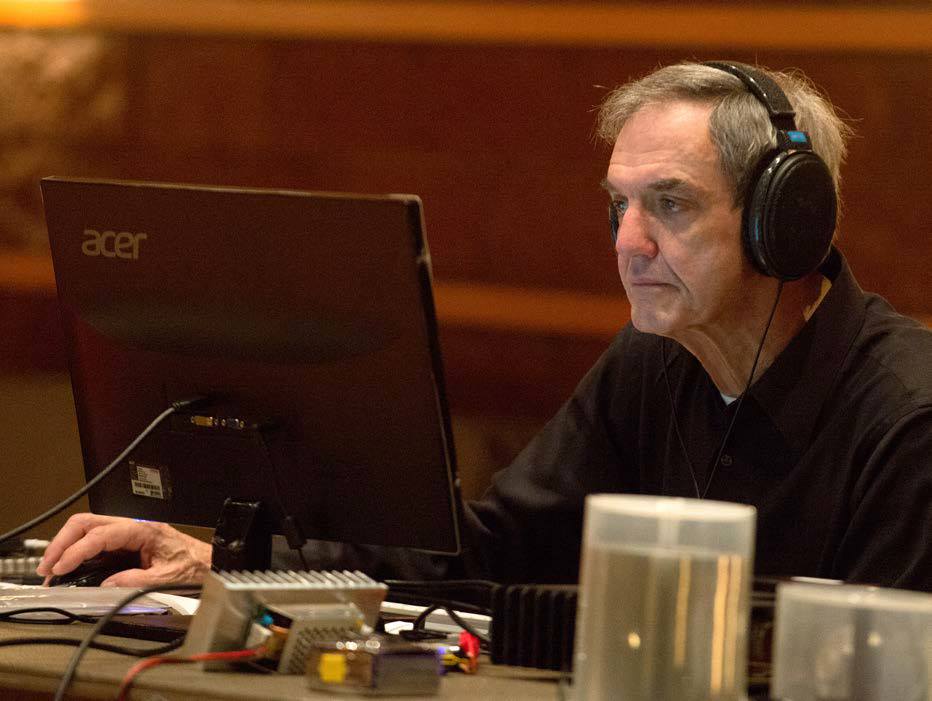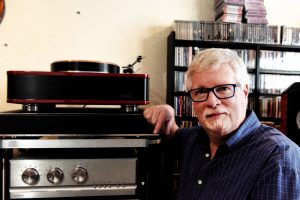Tom Caulfield is NativeDSD's mastering engineer and an accomplished DSD multi-channel recording engineer. I've had the pleasure of getting to know Tom over the past several months via a series of email conversations as he's tried to help me understand the ins and outs of some of the digital technology with which he works every day. Tom understands DSD and DXD, and he's very knowledgeable in the use of Merging Technologies' Pyramix digital audio workstation. He has graciously agreed to extend our conversations in the following email interview.
Tom Caulfield at recording session for Yarlung Record's James Matheson album in Samueli Theater at Segerstrom Center for the Arts in Costa Mesa. Photo by Cooper Bates courtesy of Yarlung Records.
Rushton Paul: Please tell us a bit about your background and what you do for NativeDSD as their mastering engineer.
Tom Caulfield: I'm a recording and mastering engineer specializing in DSD surround recording. At NativeDSD, my job is to manage the files we offer for sale, create from the edit master file the various resolutions we offer on our website, and upload the final files to our server.
Tell me more about NativeDSD's value proposition for both the labels it represents and the end consumer.
NativeDSD's business is to provide retail sales of high resolution DSD and DXD file downloads of music originally recorded in DSD or DXD (or analog and transferred to DXD or DSD). We are one of only a very few retail providers of DSD256 and DXD download files. We serve both end users who value high resolution in their music and music labels that see value in making such high resolution files available.
NativeDSD delivers files with enhanced and consistent metadata. I work with Ted Brady (who knows all things JRiver, tagging, and archiving) to insert enhanced metadata into the DSD or DXD files before we place them on the server. This way, all of the files sold by NativeDSD have consistently formatted and more complete metadata across all of the labels we represent.
NativeDSD also offers as a service to our partner labels, through our Higher Resolution Program (HRP), the generation of additional DSD resolutions. This HRP service is available to those labels that provide us their edit master. The HRP supports DSD resolutions to DSD512 and the possibility of DSD1024.
Can you explain what you mean by an edit master?
An edit master is the earliest stage of recording production, where all the elements of the recording have been assembled, edited, and post process sweetened (any EQ, compression etc.). It is created prior to production of the deliverable formats. The edit master may be in either PCM or DSD format depending on the post processing requirements and producer's album recording objectives.
The edit master is the file from which the final deliverable file types (the various DSD bitrates and PCM sample rates) are created.
You work in DSD recording technology and you once mentioned to me that DSD was virtually an analog signal. Can you explain that?
First, let's differentiate PCM (Pulse Code Modulation) and PDM (Pulse Density Modulation). PCM is what most music listeners know from the original Redbook CD standard and the now higher sampling rates. PCM is a format of measured amplitude values, expressed as progressive digital binary samples (2's complement binary words of a specified bit depth) of the audio waveform, at some sample rate.
I like to think of PCM as analogous to a movie film. In a movie film, we have discrete frames of standalone pictures chained together to yield motion when played out. In PCM, digital value samples of the audio at some sample rate (44.1, 96.2, 192.4, etc.) are chained together to yield audio when decoded and played out.
DSD is a very different thing. For me, the most difficult part of understanding DSD was putting aside everything I knew about PCM digital encoding and DSP (Digital Signal Processing). There's no equivalency.
DSD, or the more correct non-marketing term Pulse Density Modulation or PDM, is not a digital value representation system like PCM. It's a modulated carrier system, like radio transmission, only using a bit clock (square wave) as the carrier instead of a high frequency sine wave. In fact, DSD/PDM is an analog-like signal (due to the very large difference in the carrier frequency band versus the audio frequency band).
DSD/PDM is not digital in the form most people understand and perceive the word "digital" because there are no expressed digital values in DSD/PDM as there are in PCM. Only changing 1's and 0's bit densities proportional to the modulating audio signal level.
Because DSD/PDM is an audio modulated carrier, the 1s and 0s bit densities are defined by the music signal. There are no MEASUREMENTS taken, nor any digital VALUES represented—just a bit stream of 1s and 0s whose density is proportional to the modulating signal level.
Hmmm, I think I understand what you're saying. A picture would help.
Here's a picture from a Wikipedia article on PDM. This is two periods of a sine wave, sampled 100 times and represented as an example PDM bit stream.
01011011111111111111011010100100000000000001000100110111011111111111110110...
In pulse-density modulation, a higher density of 1s occurs at the peaks of the sine wave, while a lower density of 1s occurs at the troughs of the sine wave. (Diagram in public domain.)
The irony of the PCM versus DSD preference debate is that we've all been recording and listening to DSD/PDM for the last two decades and more. This is because all available A/D converters, and the vast majority of D/A converters, are front-end or rear-end loaded with Sigma-Delta modulators, the basis for PDM encoding.
You can see this in the diagram below:
Analog-to-Digital and Digital-to-Analog converter showing the processing flow from analog input to digital and then from digital to analog output. Diagram by permission of Andreas Koch. For more details, see his article DSD – The New Addiction by Andreas Koch.
The analog source moves through a Sigma-Delta Modulator* whose output is DSD/PDM. From there, the DSD/PDM signal is passed into a digital decimation filter to create the PCM data stream. To convert back to analog, the PCM data goes into a DAC containing a digital interpolation stage and a Sigma-Delta Modulator creating the audio signal output
By contrast, the processing of a DSD/PDM file follows the dotted line path, by-passing the decimation and interpolation filters.
I point this out because every PDM-to-PCM and PCM-to-PDM process is lossy. That is, you cannot convert the latter back into the former because there has been data loss. Whether that's important or not is the subjective preference argument.
We often see files offered in either DSD/PDM or DXD/PCM. Which should I choose?
First, you should choose the format/resolution that your DAC will most happily process with the best sonic result. You can determine this by doing some comparative listening. Listen to alternate resolutions of the same file created from the same source file. Two good resources for finding files that will allow you to do this kind of controlled comparisons are the 2L Records HiRes Download Test Bench and the NativeDSD Starter Pack. You can download sample files derived from the same edit master in different resolutions and formats.
The big variable, however, is your DAC. If it's a chip-based Sigma-Delta converter, as are the majority of DACs, then supplying it with a DSD/PDM bitstream previously converted to DSD/PDM in a processor with greater resources will potentially sound more analog and pleasing. You're giving your DAC a bit of help through choosing an optimal format and resolution ahead of time. This can take processing load off of your DAC possibly achieving a more pleasing outcome. You really have to do some listening comparisons to determine what will work best for you and your DAC.
How does NativeDSD receive files from the labels? How frequently do you receive DSD files as the originally recorded format that have not been further processed in PCM?
The vast majority of content we receive has been post processed in DXD (352.8kHz PCM), whether or not it was recorded in DSD or DXD. These recordings come to us in either of two forms: the deliverable release DSD bitrates of the label's choosing, or the DXD edit master itself.
For processing DXD edit masters we employ both Pyramix Album Publishing and Signalyst HQ Player Pro to produce first generation DSD deliverable bitrates, including DSD512. This is the NativeDSD High Resolution Program (HRP).
We also receive originally recorded DSD files from several labels that have not been converted to DXD for post processing. Just Listen Records, Eudora, Yarlung Records, and a few others make many of their recordings this way. The number of companies making this commitment to process directly to DSD and keeping the file in DSD all the way to the DSD edit master is relatively small, but growing.
Pretty much all commercial acoustic music recording is analog from the microphone to individual A-to-D channels. Each of these channels are recorded, tracked, and then retrieved in post-processing. Post processing involves the mixing and balancing of the individual recorded channels while editing the approved takes into a final edit master recording. Additionally, the recording's producer and engineer may elect during post processing to apply enhancing processes such as EQ, reverberation, compression, etc. Why, when, how and how much of this may be desired is a much longer conversation—it's ultimately a decision the producer is making to achieve a desired objective. It is, after all, a piece of art.
Thank you very much for taking time to share all of this information with us.
Thank you for inviting me here. It's been my pleasure.
* For the more technically adventurous, here's a link to a document showing the operation of a simple Sigma-Delta modulator, which is the first step in the diagram above from Andreas Koch of a typical A/D and D/A converter. Tracing the steps in the conversion example table of this document will provide a strong understanding of the operation of a Sigma-Delta modulator (the point "D" is the PDM bit and "Y" is the PCM output).












































